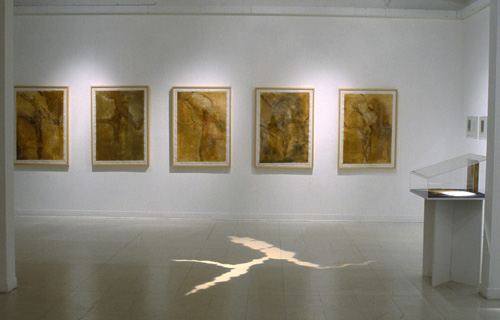"Small but expansive
show finds
its sense of place"
Santa Barbara News-Press, Friday, August 1, 2003
MARY HEEBNER, "A SENSE OF PLACE"
When: Through Sept. 12
Where: UCSB College of Creative Studies gallery
Gallery hours: Monday through Friday, 10 a.m.-5 p.m.
Information: 569-2695
By Josef Woodard
NEWS-PRESS CORRESPONDENT
|
|
It takes a heap of hyphens to get at the essence of
Mary Heebner. A collagist-painter-poet-journalist-journal keeper-itinerant,
Heebner has been following a restless heart and skillfully avoiding easy
categorization throughout the many years of her career(s).
One of the surprising, tidy feats of her current exhibition at the College
of Creative Studies gallery, "A Sense of Place," is the coherent
means by which it taps into most of her endeavors. It celebrates the external
world in its infinite variety, and her own multidirectional pathway through
it.
This is an inherently modestly-scaled show, limited by the gallery's dimensions,
and Heebner wisely limits the expanse of its contents, for the sake of
focus. Rather than cull bits and pieces from her art and travels, she
presents reportage and artistic projects from three distinct locales:
the caves of Lascaux and Rouffignac, France; from Ayutthaya, Thailand,
whose damaged religious icons show the effect of Burmese brutality hundreds
of years ago; and the sprawling spaces of the unpeopled American West.
Larger works are mixed with small paintings and book projects, reflecting
the artist's fluid approach to media.
Each segment in the exhibition is a self-sustaining story unto itself,
and the combined force of the three distinctive "chapters" gain
energy from the cumulative whole. As she writes in a statement, travel
"makes me take risks, reveals and undermines my prejudices, and stretches
my conceptions about art." That notion of the symbiotic relationship
of art and traveling, with compassion and sense abuzz, may be the show's
leitmotif.
In 1997, Heebner had a rare opportunity to be one of a few visitors invited
inside the ancient Lascaux caves, officially closed to the public since
1963. She interpreted the visions of the cave's famed, prehistoric paintings
in a four-panel work called "Lascaux: Gold to Airy thinness beat
... ," a series of ochre pigment drawings which personalize Heebner's
close encounter with pre-history. With this piece, a hint of the ancient
reality contained in the cave painting is somehow seamlessly merged with
a post-20th century abstract sensibility.
Similar epoch-leaping, and culture-leaping, is at the core of her installation
piece along the gallery's back wall, "Bodhisattvas at Ayutthaya."
Here, Heebner is interpreting and processing a bittersweet reality: Rampaging
Burmese in the 17th century attacked the village and, in a final insult,
decapitated its Buddhist deities. And yet the sacred sculptures remain,
a testament to divine empowerment in the face of tragedy and defacement.
Heebner depicts these defaced Bodhisattvas in photos printed on sheer
paper scrolls, and places a barrier of bricks and photographs on the floor,
turning the sum effect into a shrine to spiritual resiliency.
In the large, composite piece called "Bright Angel: The Grand Canyon,"
Heebner's residual impulses as a collagist and texturalist bubble up to
the surface. A neat yet intuitively rugged assembly of modules and recurring
shapes conspires toward a construction of nine panels. Centering this
series of images — which range from natural reflections to abstract
figments of an active visual imagination — are fragments of her
poetic accounts of her canyon visit. In a final, ironic wink, she refers
to the tough interface of poetic attitudes and physical rigors of traveling,
"viewed as a place to get across, it was hell." But a good hell,
with assorted rewards in the traversing.
For Heebner, the "sense of place" is a state of mind as well
as a stop along a continuing journey-in-progress.
________________________________________________________________________________________________________________________________
Lascaux: Gold to Airy Thinness Beat, Ochre paintings
with map of cave of Lascaux projected onto gallery floor with light
|

